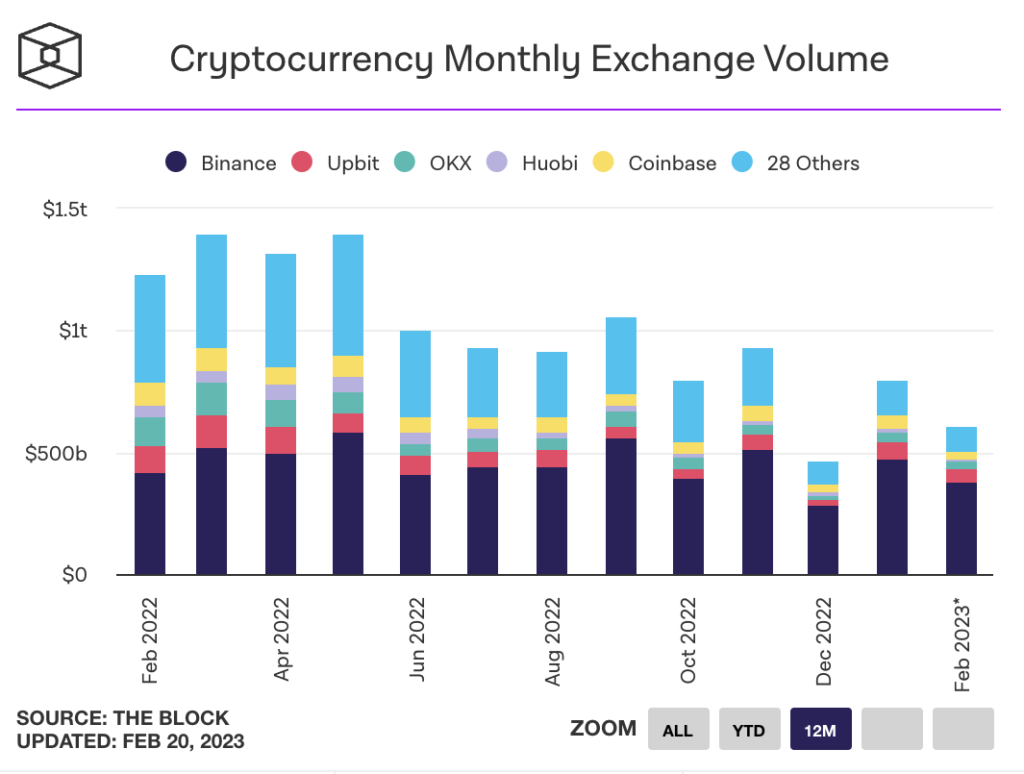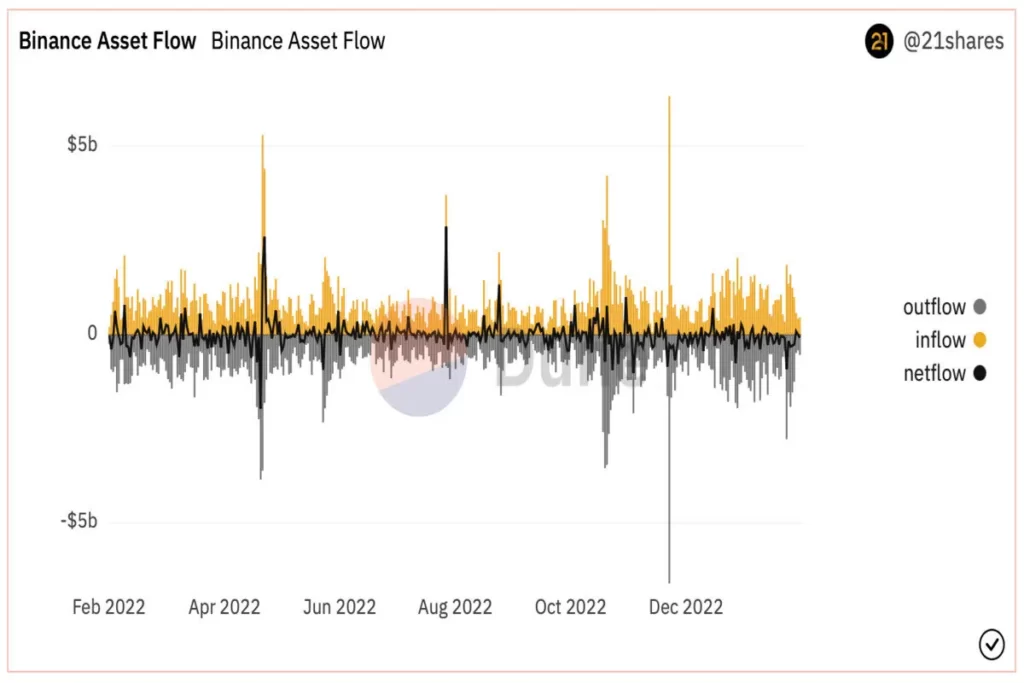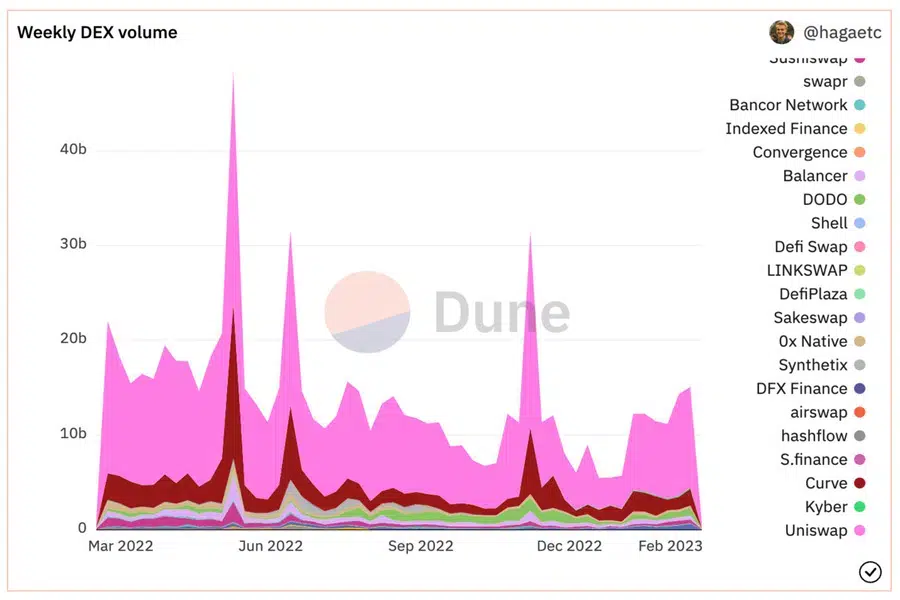The cryptocurrency industry has been through phases of euphoric bull markets and dispairing winters. However, unprecedented black swan events have characterized the most recent bearish period. From the Terra Luna demise, the fall of Three Arrows Capital, the insolvency of major crypto lending platforms like Voyager, BlockFi, and Celsius to the catastrophic implosion of the second largest cryptocurrency exchange at the time, FTX, the crypto market has had to withstand what may have been the toughest test in its nascent history.
Following the FTX debacle, Binance, the largest crypto exchange, is under regulatory scrutiny, leading to speculations about the future of cryptos should the firm fall. A potential downfall not only results in dramatic price declines but also a potential narrative shift towards decentralized exchanges.

An Overview of Binance
Since its establishment in June 2017 by software developer and entrepreneur Changpeng Zhao, commonly known as CZ, Binance has risen swiftly to become the most popular cryptocurrency exchange. Compared to its competitors, Binance has dominated the charts in almost all metrics, from trading volume and liquidity to the number of users.

The rise to prominence as the largest crypto exchange can be attributed to several factors. Binance offers a wide range of cryptocurrency trading pairs and fiat support for several countries. This has enabled the exchange to achieve high levels of liquidity, which are essential for giving its users a seamless trading experience. Furthermore, the platform is an ideal option for both new and experienced traders due to its user-friendly interface, seamless fiat onramp process, and low trading fees.
Binance has been a trailblazer in the market by providing experienced investors with various trading options like margin trading and futures contracts. Additionally, Binance has been proactive in establishing partnerships with blockchain projects and payment providers throughout its history, including Swipe, Chainanalysis, and Oasis Labs, to name a few. These collaborations have aided in the widespread adoption of web3 applications and cryptocurrencies.
With a committed strategy to user protection, proactive compliance, and a readiness to follow regulations, Binance has established itself as the most dependable exchange among the crypto community. However, trust in centralized crypto exchanges has hit an all-time low since the collapse of FTX. As a result, Binance now faces a two-pronged challenge. Investors are turning their backs on central intermediaries managing their crypto assets, and regulators are criticizing the exchange’s operations and internal audits, thereby casting a cloud of anxiety among the entire crypto community.
Controversies Surrounding Binance
The fallout of FTX has ushered in a new movement for the need for more transparency of funds among centralized crypto exchanges. To prove solvency and regain trust among crypto investors, several exchanges, including Binance, have adopted the Proof of Reserves (PoR) concept to maintain complete transparency and accountability.
This article provides an in-depth guide to understanding the PoR model.
Despite a shift towards greater transparency, regulatory allegations and negative media attention abound for Binance. The Wall Street Journal claimed in a report after the largest exchange released its PoR assessments that the audit contained warning signs and displayed FTX-like behavior by showing that the 1:1 ratio of reserves to customer assets was not achieved.
Furthermore, according to a Reuters report, the U.S. Department of Justice (DoJ) may sue Binance and its founder CZ for alleged violations of criminal sanctions and money laundering laws. More recently, regulatory action against Paxos regarding the creation of the Binance USD (BUSD) stablecoin has been flagged by the U.S. Securities and Exchange Commission (SEC), which has referred to it as an unregistered security.
The spread of these negative reports against the backdrop of the FTX collapse has brought about a high degree of uncertainty among Binance users. The recent acceleration of outflows of funds from Binance has evidenced the level of anxiety.

Despite the widespread negative media coverage and public accusations against Binance, CZ has taken to Twitter to overtly reassure users and investors. CZ argues that the recent escalation of attacks is merely an attempt to spread fear, uncertainty, and doubt (FUD). While there is still a lot of trepidation on crypto Twitter and in the community at large, several well-known commentators have come forward to support CZ and Binance.
Impacts on the Crypto Market if Binance Fails
The culmination of the recent negative reports against Binance has driven investor sentiment to new lows and influenced negative price action across the crypto market. It has also sparked discussions about what would happen to the cryptocurrency ecosystem if Binance went bankrupt. While bankruptcy filings for the largest crypto exchange are far from a reality, it was hard to believe that FTX would go bankrupt not long ago.
Price declines
Market sentiment and investor psychology play a significant role in influencing the direction of price swings in crypto. As witnessed after the FTX collapse, the entire crypto market cap took a steep decline caused by widespread panic.

A potential insolvency of Binance would not only result in a protracted crypto bear market but could also plummet crypto prices, which would eclipse the post-FTX price crash. This is because Binance caters to a larger and more global audience than FTX did.
Impact on Liquidity
Binance amasses a 62% market share among centralized cryptocurrency exchanges, according to a report published by CoinGecko. Binance is one of the most liquid cryptocurrency exchanges due to the large volume of buyers and sellers actively trading on the platform. This promotes price stability and guarantees that traders can conduct their transactions quickly and effectively. If Binance were to go bankrupt, this liquidity would disappear and cause a ripple effect across the crypto market.
A Binance bankruptcy could cause a temporary loss of confidence in the cryptocurrency market, leading some investors to withdraw their funds or avoid making new investments. Since there would be fewer buyers and sellers of cryptocurrencies, this could exacerbate liquidity issues in the market.
Strict Regulation
A Binance bankruptcy would significantly influence the regulation of cryptocurrencies. A global regulatory framework could be established in response to a collapse of this magnitude to safeguard investors. This could ultimately stifle the industry’s growth and innovation. For instance, regulations may make compliance more expensive and challenging for cryptocurrency exchanges and other market participants. This greatly burdens new businesses, startups, and smaller market participants.
A Seismic Shift From CEXes to DEXes
Mount Gox and FTX may have ignited conversations about upholding the crypto ideals of decentralization. However, a Binance bankruptcy could be the final straw for crypto participants placing trust in centralized exchanges (CEX). The repercussions of a Binance collapse could trigger a paradigm shift that goes back to the decentralized roots of crypto. A new narrative is already in place, with users moving to decentralized exchanges (DEX) for more autonomy and control over their assets. As a result, DEX projects like GMX, DYDX, and Uniswap could witness an uptick in the number of users.

A Growing Awareness Towards Self Custody
With users migrating from centralized platforms, a potential bankruptcy of Binance may also serve as a catalyst for newcomers to the industry to recognize the value of self-custody and adopt more thorough risk management processes.
Bitcoin and Blue-chip Cryptocurrencies Survive
The cryptocurrency market has repeatedly shown itself to be highly adaptable and resilient. The market has weathered major price drawdowns, hacks, and regulatory clampdowns in its history and has persevered to grow and evolve. The fallout from a Binance insolvency would undoubtedly cause a negative ripple effect across the crypto ecosystem, stunting growth in the short term. Centralized tokens, small, and micro-cap projects may suffer significantly from such a collapse, though it is unclear which projects will be hit the hardest.
However, the sheer size, innovation, and adoption in Bitcoin and well-established projects like Ethereum could ultimately survive a Binance bankruptcy. Bitcoin and other cryptocurrencies are entirely separate and independent from centralized cryptocurrency exchanges. The underlying technology and innovation behind crypto projects will remain despite the negligence of certain bad actors in centralized systems.
Closing Thoughts
The fall of FTX has ushered in new stringent regulatory scrutiny over the crypto ecosystem and centralized exchanges. Binance seems to be the vector for attacks recently. While the extent of regulatory oversight is still unclear and the allegations against the exchange remain a developing story, it is critical to recognize the abundance of misinformation across crypto social circles.
The ecosystem and community would undoubtedly suffer from a Binance collapse. In the end, though, the crypto ethos is called into question: Can a centralized entity crush an entire social movement in favor of a decentralized future? We think not.



![Token2049 Singapore Exclusive 10% Discount Code for Asia’s Premier Crypto Event [DROOMDROOM10] 7 Token2049 Singapore 2023](https://droomdroom.com/wp-content/uploads/2023/02/Token2049-Singapore-202-150x150.jpg)
















